

DigitALL: Innovation and Technology for Gender Equality
Aisha mohammedelhassan hamid.
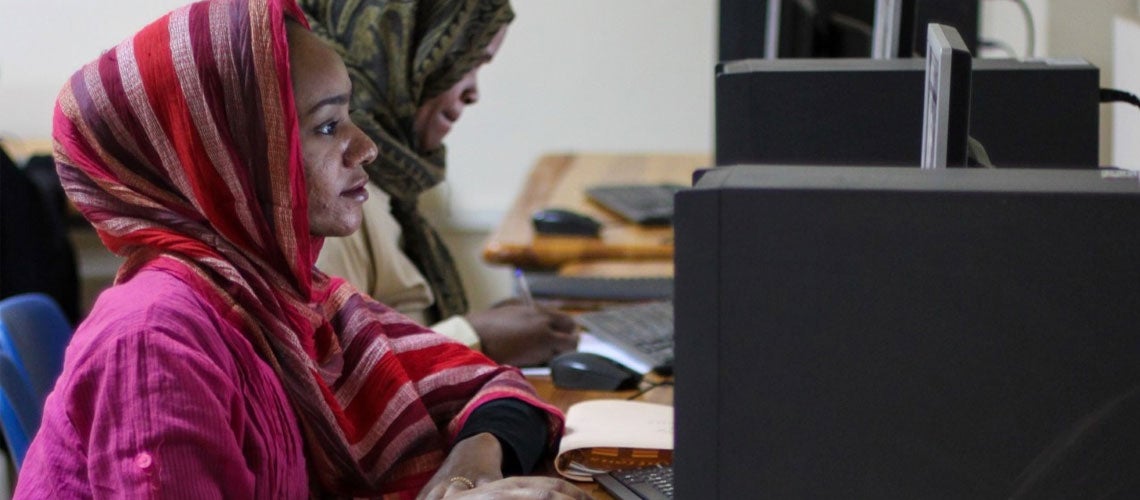
This year’s UN theme for International Women’s Day was DigitALL – Innovation and Technology for Gender Equality . Digital technologies are at the forefront of development and provide a unique opportunity for countries to accelerate economic growth and connect citizens to services and jobs . But digital technologies could lead to more economic and social inequalities unless women are empowered by having access to technology and acquiring the skills needed to benefit from it.
Digital technologies for gender equality
I have dreamed of gender equality that not only provides equal access to opportunities but also guarantees the equal ability to benefit from them. Unfortunately, women struggle in tons of battles to achieve the same goal that men can achieve with less effort; this because women are still tied down with societal responsibilities and frequently need to fight, psychologically, economically, socially, and even physically to get ahead. There is a wide spectrum of challenges faced by women across social classes, economic classes, and geographical areas.
Women in remote areas and lower social/economic classes lack access to the power needed to charge their phones, if they are lucky enough to even have phones. Women are 7% less likely than men to own a mobile phone and are 16% less likely to use mobile internet; the situation is worst in Sub-Saharan Africa and South Asia with gender gaps of around 37% and 41% respectively ( The Mobile Gender Gap Report 2022 - GSMA ).
For this category, the journey for women’s digital gender equality starts by supporting their acquisition of mobile phones, provision of sustainable and affordable means to charge those phones, cheap or free call/internet tariffs , provision of free hotlines to answer their inquiries, and delivery of digital training.
In my previous blog “Dev-Techs”: Accelerating digital economy in the post-COVID-19 era I mentioned that - Digital exclusion leads to social and economic exclusion. The bright side is that the opposite is also true!. Thinking positively, there are huge opportunities for women to unlock better social and economic lives if they acquire the skills needed in the digital economy; women should be empowered by having access to technology and acquiring the skills needed to benefit from it. They need to know how to use phones, access the internet, search for information, share information at the level of buying/selling goods, be able to access funds, and do e-payments.
“Innovation is the process of creating value by applying novel solutions to meaningful problems.” - Joe Dwyer, What Is Innovation?
When I was an undergraduate student, I was excited about knowing and experimenting with new technologies and trends, irrespective of the value that they brought in my context; I can say that I was thinking externally. Thereafter, through reflection and connection to my context, I built a development-centered mindset. I am still excited about technology, but I am more passionate about utilizing technology to bring real value and to use technology to solve everyday problems in my community, problems we might not even know about! This shift in my mindset let me approach my work in digital financial services with purpose. Having purpose let me work hard day and night in subsidy distribution in Sudan through digital financial services during the COVID-19 crisis. The same sense of purpose inspires me now, faithfully walking extra miles, spreading mobile money across the continent through my current occupation as a Solution Architect of mobile financial services.
Communities must be encouraged to innovate in solving their problems, they are the ones who suffer now, and the ones who will pick the fruits of their efforts later. It’s better to harmonize research and development efforts by attracting national talents to provide solutions to the problem of their community. Innovation is needed in the learning content itself, using micro-doses that are customized around the exact needs of women. Innovation is needed in building business models that are gender-focused around the currently available and affordable technologies.
“Achieving gender equality requires the engagement of women and men, girls and boys. It is everyone’s responsibility.” - Ban Ki-Moon.
I am enjoying my life now, supervising two undergraduate students in their final year project that aims to build an e-learning platform for a non-governmental organization that is concerned about education. It is a great opportunity for those students to be in touch with the challenges of their community and to contribute to solving them. I am brainstorming to see how solving community problems can be encouraged further, focusing on the theme of women’s empowerment through local or regional competitions.
Whoever you are, regardless of your gender, social occupation, and role, you have something to contribute!
If you are a man … try to walk in women’s shoes, empathize with them, and lend a helping hand.
If you are a woman … try to connect with other women and share inspiration and support.
If you are a mother or older sister… be a role model and be part of the new social norms that support women.
If you are a woman experiencing success and, know of opportunities, share your knowledge and bring another female up with you!
Get updates from Youth Transforming Africa
Thank you for choosing to be part of the Youth Transforming Africa community!
Your subscription is now active. The latest blog posts and blog-related announcements will be delivered directly to your email inbox. You may unsubscribe at any time.

Winner of the 2021 Blog4Dev competition for Sudan.
Join the Conversation
- Share on mail
- comments added
- Get involved
Innovation and technology enabling gender equality
March 7, 2023.
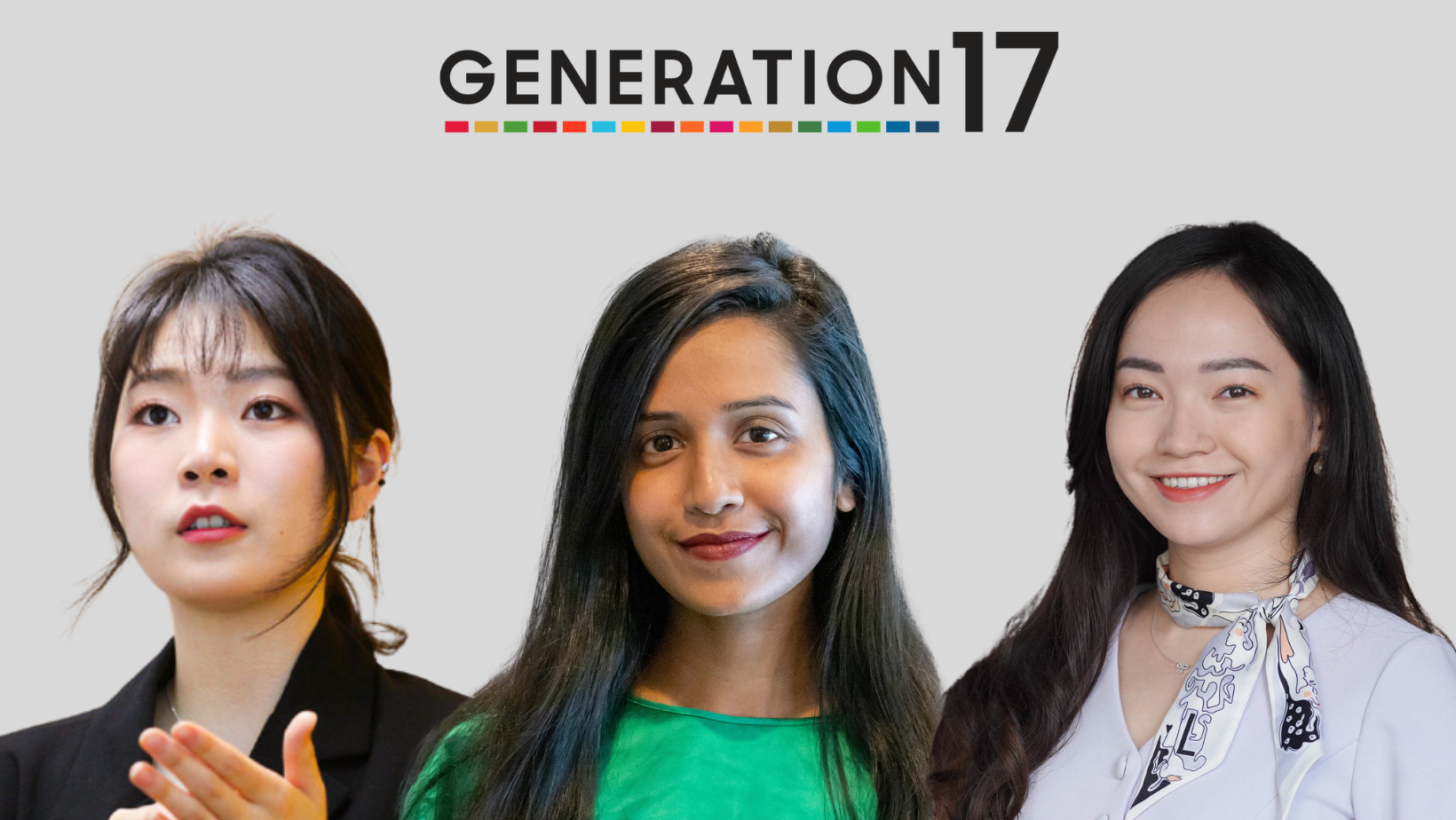
We’re living in the era of the digital revolution. Technology has changed our lives, including the way we access education. But we need to be careful to not continue existing patterns of gender inequality. Innovation and technology can support our work for gender equality and the empowerment of all women and girls for sustainable development. Transformative technology means inclusivity in education but also in other spaces where women still are underrepresented. On this International Women’s Day, we want to highlight the importance of technology as a tool to reduce the gender gap. In 2020, UNDP together with Samsung launched the initiative called, Generation17. Today, 14 young leaders from different parts of the world have benefited from this digital partnership, so we invited three young female leaders from Bangladesh, Viet Nam and South Korea to share their thoughts and reflections. These young leaders have experienced the perks of having technology as an ally, because technology is helping them as women entrepreneurs and increasing their impact on other young women.
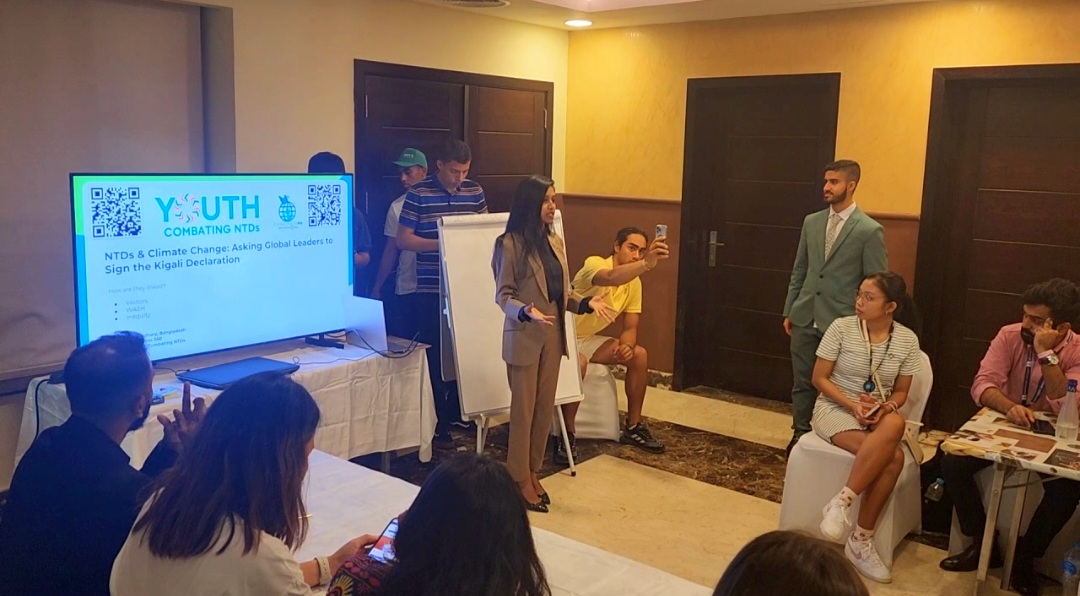
Technology to connect and empower women.
Shomy, co-founder of Awareness 360, Bangladesh
I am genuinely proud of my organization, Awareness 360 , because we mainstream gender equality in all our decisions, levels, and operations. Currently, 67 percent of our staff are women, who represent diverse nations and hold various leadership roles within our functional teams. We ensure there is a gender balance among speakers whenever we host a panel discussion or event (excluding the moderator). We maintain zero tolerance for any form of abuse ensuring the safety and well-being of all our members, especially women, both in physical and virtual space. We also provide period leave for the staff who menstruate. We make the utmost effort to promote women's rights throughout the year by paying attention to these little details.
Given Awareness 360 is an international organization; we heavily leverage technology to engage with women from all around the world and equip them with transferable skills and resources that will enable them to be meaningfully empowered both within and outside of Awareness 360. The bulk of the participants in our yearly youth development programme are women. Not only do we provide opportunities to women from around the globe, but also from conflict-ridden countries. Our recent Fellow of the Year is a woman from Yemen, who will be rewarded with a fully funded international trip from Awareness 360, as recognition for her incredibly impactful work in her community. Last week we heard from a young woman in Afghanistan, who is fighting for girls’ education in her country, and shared how motivated she feels by engaging with inspiring young people through our global platform and how she is gaining tangible skills to apply in her work through the Awareness 360 Fellowship Programme.
Without access to technology, connecting this powerful group of women and empowering them to be civil society leaders would not have been possible.

Using technology to position young women in their fields.
Yejin, founder of DoBrain, South Korea
Technology empowers me. Technology can increase my capacity to solve problems and reach more people who need our solutions.
Many children with learning disabilities around the world do not have access to diagnosis and specialized education methods. Low-income communities and families are the most affected. Through DoBrain, my AI-based learning platform, I offer affordable school-readiness solutions for children, including those with learning disabilities. I use technology to generate inclusivity, as in DoBrain we’re able to digitally screen children's development and help them get the help that can cost over US$100 an hour, through an application that they can use at home.
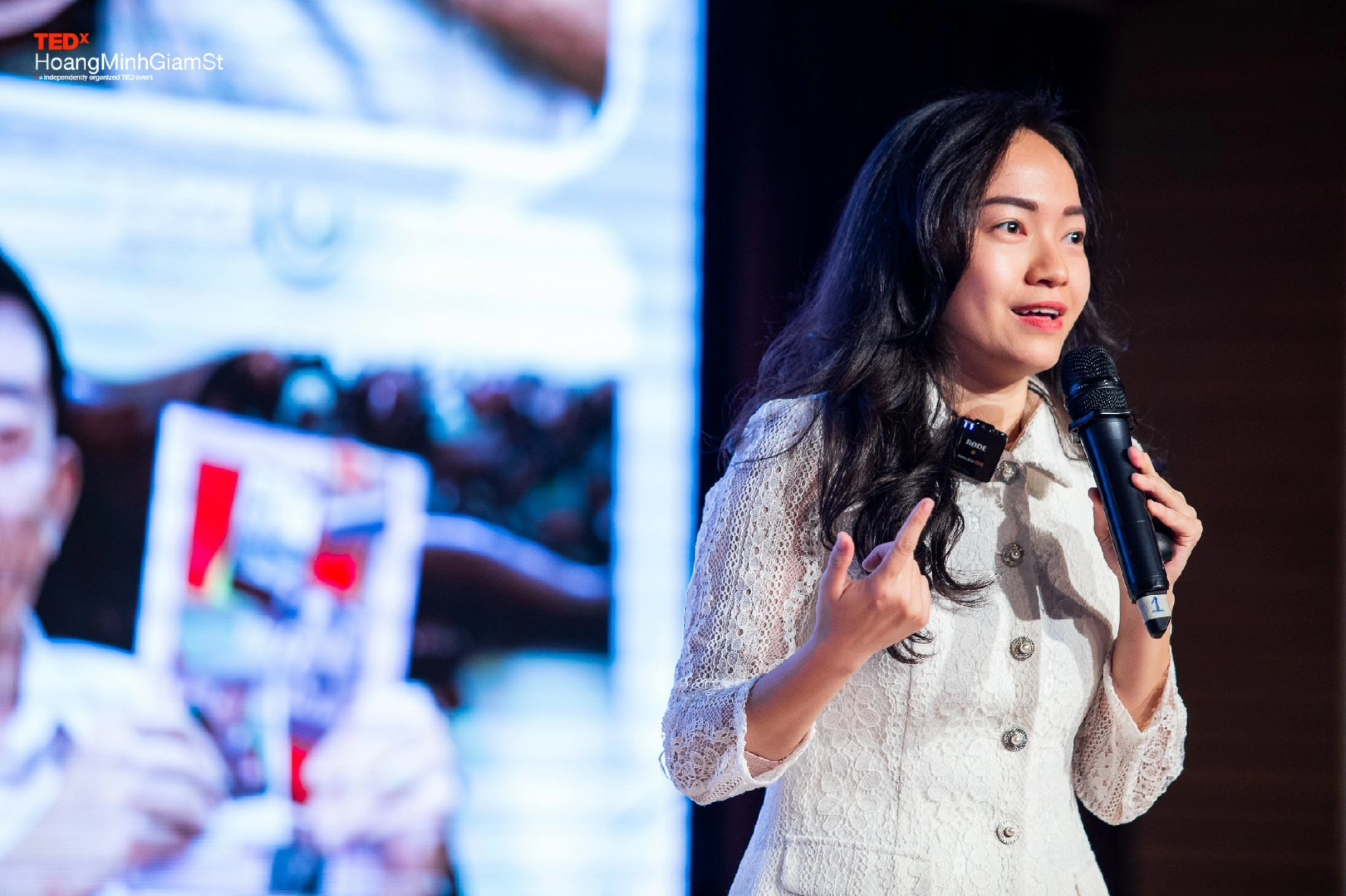
Technology can also be a powerful tool to bridge generational gaps.
Thuy, founder of HASU , Viet Nam
As a young woman entrepreneur who has been working on technology capacity building for the older adults and providing them memoir writing services, technology has been a game-changer for my business. It has made it easier for me to collaborate with clients. Instead of having to meet in person, I can conduct interviews over video chat or phone or collaborate with them through online activities. This is especially beneficial for elderly clients who may not be able to leave their homes or who have mobility issues.
In addition, technology has given me access to various tools and resources that make my job easier. For example, there are software programmes that can transcribe audio recordings, saving me time and allowing me to focus on the creative aspects of the writing process.
Finally, technology has helped me provide emotional support to my clients. With the pandemic forcing many of us to work remotely, I have had to find new ways to connect with clients and offer emotional support. Through video calls and messaging apps, I have been able to stay connected with my clients and provide them with the support they need during this difficult time.
Technology has the power to bridge the gap between generations, unlocking a world of information, communication, and connection for elderly people that was once unimaginable.
Today, we’re still working on reducing the gender gap, particularly in technology when it comes to access to it. As the Generation17 young leaders have mentioned along this blog, technology is critical to keep increasing their impact as social entrepreneurs but also to generate inclusivity to leave no women behind and achieve the 2030 Agenda.
Generation17 supports a group of inspiring young leaders aged 18 to 32 dedicated to innovating for humanity and mobilizing global communities. To learn more about this initiative and meet the Generation17 young leaders, the visionaries, advocates and entrepreneurs building a better future, visit generation17.undp.org .

Equipping young Yemenis with skills for peace and development
Peace and sustainable development are inextricably linked; in a peaceful society, businesses can thrive, jobs are created, and access to services is enhanced, lea...
Partners pledge to cooperate in addressing global challenges

Improvement of Digital Skills of Women Entrepreneurs for Better Business
Organised by the United Nations Development Programme (UNDP) in Serbia, in cooperation with the Office for Information Technology and Electronic Government of the...
Climate Smart Youth Farmers Equipped for Improved Production
From fruit vendor to ceo: maka's inspiring journey.
Innovation and technology for gender equality: Echidna Global Scholars taking action
Subscribe to the center for universal education bulletin, nasrin siddiqa , nasrin siddiqa executive director - education & cultural society, bangladesh, 2019 echidna global scholar - the brookings institution arundhuti gupta , and arundhuti gupta 2021 echidna global scholar - center for universal education, brookings institution, founder trustee and ceo - mentor together anthony luvanda anthony luvanda 2022 echidna global scholar - brookings institution, co-founder & executive director - magharibi innovation hub, senior lecturer, information technology department, defence forces technical college - national defence university-kenya.
March 8, 2023
Every year, the UN marks International Women’s Day by identifying a critical challenge impacting women and girls and advocating new policy tackling the issue. As the world continues to grapple with the implications of AI chatbots and the strong link among social media, misinformation, and democracy , this year’s theme “ DigitALL: Innovation and technology for gender equality ” examines the link between digital technologies and gender.
At the forefront of building an inclusive digital world for girls and women are several Echidna Global Scholars working on gender equality in and through education across the Global South. Their policy research and praxis addresses pressing issues such as barriers to STEM education in rural Bangladesh , the economic potential of digital mentoring in India , and the gender divide in digital technology courses and careers in Kenya .
For this year’s International Women’s Day, we asked these three alumni scholars to share their reflections on the digital gender divide and the important work that lies ahead in imagining a more digitally inclusive world.

It is time to think whether innovations and technology will be utilized to ensure equality and rights to accessing education and economic opportunities for women or to make women more vulnerable. Considering the theme of this year’s International Women’s Day, we need to make a policy of digitalization in empowering women and ensuring girls pursue their interests in STEM and break down gender barriers.
We need to ensure that emerging technologies and artificial intelligence will be used to improve gender equality significantly by creating new opportunities and removing barriers for women and girls, rather than leaving millions of poor women workers unemployed. In Bangladesh, women face challenges to accessing education and economic opportunities. By using technology to provide educational resources, training opportunities, and access to information, we can empower women.
The world needs to simultaneously rescue women with immediate measures, and on the other hand, strengthen the next generation to deal with super-fast technology and digitalization. Researchers can play a vital role in informing need-based policy and understanding its impact. Digitalization should be human, and especially women-friendly. It would make the lives of women more comfortable and easier, rather than making them insecure. It would contribute to girls’ education, stop violence and trafficking, helping make girls and women aware of places and people, ensure digital marketing and entrepreneurship, provide health care information and services to women in rural areas and free educational resources and training, and enable the development of new skills and access to new economic opportunities for underserved women.
We can create a brighter, more equitable future for women around the world.

We stand at an important juncture today where technology can become either one of our most consequential allies—if channeled effectively in our fight for gender equality—or if left to be shaped by the existing structures of society, yet another platform for the exclusion and disempowerment of women.
One of the most positive trends of the last four years had been that the gender gap in the use of mobile internet had been reducing. Worryingly, the rate of adoption by women has seemingly stalled in 2021 . My nonprofit organization, Mentor Together, runs a large career mentoring program based out of India that thousands of young women in universities access via their mobile phones. The increasing access to phones presented an avenue to counter the restrictions placed on the movement and freedom of young women and help them virtually access personalized career mentorship from inspiring role models across the country. Without concerted efforts to increase mobile phone access, women will lose out on even this avenue of learning.
The second opportunity that strikes me as critical for India is that the design of digital communities should very intentionally bring in ways to champion gender- transformative social norms . I found through my research that even well meaning, large communities of mentors can end up becoming limited champions because their messages never reach the people who need convincing (in this case the families and communities of our mentees). It is worrying that so much of the digital discourse in India displays the same negative gender norms with even quicker dissemination. The most powerful role of technology we have to intentionally design is positive human connection spreading in more virtuous cycles.

Digital technology has a role to play in bridging the various gender gaps within the workplace, yet we need to set in motion various interventions aimed at placing more women in the digital technology workspace.
The gender gap in the digital technology workforce begins early, as very few girls take up digital technology-related courses at the tertiary level of education. Girls from the lowest levels of education are subjected to cumulative disadvantages that reduce their chances of ending up in a digital technology career.
My research on the subject reveals that one of the best approaches to having more women in the digital technology workspace revolves around creating interventions for mitigating the cumulative disadvantages that lead to the exclusion of women from digital technologies careers. Such interventions may include but must not be confined to: improving institutional digital technology infrastructure at all levels of education; enhancing the training of digital technology personnel within all levels of education; building girls’ interest in digital technology-related courses from the earliest years; increasing digital technology advocacy and awareness among girls; and enhancing vocational counseling on digital technology careers.
Related Content
Hina Saleem
February 7, 2023
Anthony Luvanda
December 14, 2022
Bhawana Shrestha
September 2, 2022
Education Access & Equity Education Technology Global Education
Emerging Markets & Developing Economies
Global Economy and Development
Center for Universal Education
August 2, 2024
June 20, 2024
Elyse Painter, Emily Gustafsson-Wright
January 5, 2024
- UN Audiovisual for Professionals
- UN Photo - Digital Asset Management System
- Media Accreditation and Liaison
- Meetings Coverage
- Media Stakeouts
- Press Conferences
- Agencies, Funds & Programmes
- Conferences
- Economic and Social Council
- General Assembly
- High Level Events
- Human Rights Council
- Human Rights Treaty Bodies
- International Court of Justice
- Security Council
- Side Events
- Trusteeship Council
- Audiovisual Library of International Law
- Hungry Planet Series (IFAD)
- News Stories
- UN Dag Hammarskjöld Library
- Secretary-General
- Deputy Secretary-General
- Live Schedule
Meetings & Events
Digitall: innovation and technology for gender….
8 March 2023
DigitALL: Innovation and technology for gender equality - UN Observance of International Women's Day 2023
Aligned with the priority theme of CSW67, the UN observance of IWD recognizes and celebrates the women and girls who are championing the advancement of transformative technology and digital education and curtailing the impact of the digital gender gap on widening economic and social inequalities.
The high-level event will bring together technologists, innovators, entrepreneurs, and gender equality activists to provide an opportunity to highlight the role of all stakeholders in improving access to digital tools. The opening remarks will be followed by a high-level panel discussion and musical performances.
Participants will include:
- E. Mr. António Guterres, United Nations Secretary-General
- E. Mr. Csaba Kőrösi, President of the 77th session of the UN General Assembly
- E. Ms. Mathu Joyini, Chair, 67th Commission on the Status of Women
- Marie Bjerre, Minister for Digitalization, IT Technology and Gender Equality, Denmark
- Amina J. Mohammed, UN Deputy Secretary-General, via video message
- Sima Bahous, UN Women Executive Director
- Doreen Bogdan-Martin, Secretary-General, International Telecommunications Union
- Gitanjali Rao, 17-year-old inventor, innovator, author, STEM promoter, UNICEF Youth Advocate
UN Women webpage
Digital Innovation and Technology for Gender Equality Essay in English
Published by team sy on march 7, 2023 march 7, 2023.
Digital Innovation and Technology for Gender Equality Essay: The theme of International Women’s Day 2023 is “Digital Innovation and Technology for Gender Equality”. This theme highlights the importance of utilizing technology and innovation to promote gender equality and empower women around the world.
Digital innovation and technology have the potential to break down traditional barriers and promote equal opportunities for women. From online education platforms to flexible work arrangements, technology has created new avenues for women to access education and employment opportunities that may have previously been out of reach. It has also provided women with a platform to share their experiences and connect with others who have faced similar challenges, and has enabled greater transparency and accountability in addressing issues such as gender-based violence and harassment.
Also Read: Women’s Day Essay
However, to fully realize the potential of digital innovation and technology for gender equality, it is crucial that these tools are developed and implemented in ways that are inclusive and equitable. This requires addressing issues such as bias and discrimination in the design and development of technology, ensuring that women have access to digital infrastructure and resources, and promoting digital literacy and digital rights for women.
By focusing on digital innovation and technology for gender equality, we can work towards creating a more just and equitable society for women around the world. This International Women’s Day, let us celebrate the progress that has been made, but also recognize the work that still needs to be done to ensure that women are empowered and have equal opportunities in the digital age.
Attempt Women’s Day Quiz Now!
Table of Contents
100 words essay on innovation and technology for gender equality
Below is technology and innovation for gender equality essay of 100 words.
Innovation and technology have the potential to play a significant role in promoting gender equality. By developing and utilizing innovative technologies, we can create new opportunities for women to access education, employment, and entrepreneurship, ultimately leading to economic empowerment. Additionally, technology can help break down traditional gender stereotypes and biases by providing new avenues for communication and social engagement. For example, social media platforms can be used to promote feminist activism and raise awareness of issues related to gender equality. Overall, innovation and technology offer promising avenues for promoting gender equality, but it is essential to ensure that these tools are accessible to all, including marginalized and underrepresented groups.
Know Women’s Role in Science and Technology
200 words essay on innovation and technology for gender equality
Below is technology and innovation for gender equality essay of 200 words.
Digital innovation and technology have the potential to transform society and create more equitable opportunities for all individuals, regardless of their gender. In recent years, there has been a growing recognition of the role that digital technology can play in advancing gender equality.
One area where technology has been particularly effective in promoting gender equality is in education. Digital platforms and online learning tools have enabled girls and women to access educational resources and opportunities that may not have been available to them otherwise. This has led to increased enrollment rates for girls in STEM fields and other traditionally male-dominated areas.
Digital technology has also facilitated greater participation by women in the workforce. Remote work options and virtual collaboration tools have made it easier for women to balance work and family responsibilities, leading to more equitable distribution of household and caregiving duties. Additionally, the rise of the gig economy and online marketplaces has created new economic opportunities for women, particularly in developing countries.
However, digital innovation and technology alone cannot solve the underlying social and cultural barriers that prevent women from achieving gender equality. Governments, civil society, and private sector actors must work together to ensure that digital innovations and technologies are designed and implemented with gender equity in mind. This includes promoting digital literacy and digital rights for women, addressing online harassment and abuse, and ensuring that women have equal access to digital infrastructure and resources.
In conclusion, digital innovation and technology have the potential to promote gender equality in many areas, including education, the workforce, and economic opportunities. However, it is important to recognize that technology is not a silver bullet and that broader social and cultural changes are necessary to achieve true gender equity.
300 words essay on innovation and technology for gender equality
Below is technology and innovation for gender equality essay of 300 words.
Innovation and technology have revolutionized the way we live, work and communicate. They have also played a crucial role in advancing gender equality by breaking down traditional barriers and empowering women to participate fully in society.
One of the key ways that technology has promoted gender equality is through education. Online learning platforms and digital resources have opened up new opportunities for girls and women to gain access to education and training in STEM fields and other traditionally male-dominated areas. This has helped to narrow the gender gap in educational attainment and provide women with the skills they need to succeed in the workforce.
Technology has also created new economic opportunities for women. The rise of the gig economy and online marketplaces has enabled women to work from home or on a flexible schedule, making it easier for them to balance work and family responsibilities. This has particularly benefited women in developing countries, who may face greater barriers to traditional employment opportunities.
In addition, technology has been instrumental in addressing gender-based violence and harassment. Social media and digital platforms have provided women with a platform to share their experiences and connect with others who have faced similar challenges. They have also enabled greater transparency and accountability, making it easier to identify and address incidents of harassment and abuse.
However, it is important to recognize that technology is not a panacea for gender inequality. While it has the potential to bring about positive change, it can also exacerbate existing inequalities and perpetuate harmful stereotypes and biases. It is therefore crucial that technology is developed and implemented in a way that is inclusive, equitable and promotes diversity and inclusion.
In conclusion, innovation and technology have played a crucial role in advancing gender equality by creating new opportunities for education, economic empowerment and addressing gender-based violence. However, it is important to ensure that technology is used in a way that is inclusive and equitable, and that broader social and cultural changes are also pursued to achieve true gender parity.
500 words essay on innovation and technology for gender equality
Below is technology and innovation for gender equality essay of 500 words.
Innovation and technology have the potential to be powerful tools in promoting gender equality. They can help to break down traditional barriers and empower women to participate fully in society, both economically and socially. However, to realize this potential, it is essential that innovation and technology are developed and implemented in ways that are inclusive and equitable.
One area where technology has been particularly effective in promoting gender equality is education. Digital platforms and online learning tools have enabled girls and women to access educational resources and opportunities that may not have been available to them otherwise. This has led to increased enrollment rates for girls in STEM fields and other traditionally male-dominated areas, helping to narrow the gender gap in educational attainment and provide women with the skills they need to succeed in the workforce.
However, it is important to recognize that technology is not a panacea for gender inequality. While it has the potential to bring about positive change, it can also exacerbate existing inequalities and perpetuate harmful stereotypes and biases. For example, algorithms used in recruitment or loan approval may be biased against women due to historical data that reflect unequal treatment or limited access to opportunities. Therefore, it is crucial that technology is developed and implemented in a way that is inclusive, equitable and promotes diversity and inclusion.
Innovation and technology can also play a role in addressing gender-based violence and harassment. Social media and digital platforms have provided women with a platform to share their experiences and connect with others who have faced similar challenges. They have also enabled greater transparency and accountability, making it easier to identify and address incidents of harassment and abuse.
However, technology can also be used as a tool for harassment and abuse, as seen in the rise of cyberbullying, revenge porn and other forms of online abuse. It is essential that technology companies and governments work together to address these issues and ensure that women are protected from online abuse and harassment.
To promote gender equality, it is important that innovation and technology are developed and implemented in a way that is inclusive and equitable. This requires the involvement of women and other marginalized groups in the design and development of technology, as well as policies that promote diversity and inclusion in the tech sector.
Furthermore, it is essential that digital literacy and digital rights are promoted for women. This includes ensuring that women have access to digital infrastructure and resources, and that they are aware of their digital rights and protections. Governments, civil society, and private sector actors must work together to ensure that digital innovations and technologies are designed and implemented with gender equity in mind.
In conclusion, innovation and technology have the potential to promote gender equality in many areas, including education, the workforce, and addressing gender-based violence. However, it is important to recognize that technology is not a silver bullet and that broader social and cultural changes are necessary to achieve true gender equity.

Leave a Reply Cancel reply

Your email address will not be published. Required fields are marked *
Related Posts

Yoga for Self and Society Essay – Download Free PDF
Yoga for Self and Society Essay: Yoga, an ancient practice rooted in Indian culture, has transcended borders to become a global phenomenon. The 10th International Yoga Day, celebrated on June 21, 2024, embraces the theme Read more…

The Wonder of Science Essay English – Know why Science is important!
The Wonder of Science Essay: Scientific reasoning, inventions, and discoveries have paved a path of comfort and ease for the entire human race. All economic sector has undergone phenomenal development in every sphere due to Read more…

Indigenous Technologies for Viksit Bharat Essay – Download PDF
Indigenous Technologies for Viksit Bharat Essay – Marking National Science Day 2024, the theme “Indigenous Technologies for Viksit Bharat” resonates deeply with India’s aspirations for a self-reliant and developed future. As we celebrate the remarkable Read more…
- UN Women HQ
DigitALL: Innovation and Technology for Gender Equality — UN Women and the Thai Ministry of Social Development and Human Security host the 2023 Gender Fair
Date: Friday, 16 June 2023
Author : Alexandra Håkansson Schmidt

Bangkok, Thailand — On 31 March 2023, UN Women Thailand and the Thai Ministry of Social Development and Human Security co-hosted the annual Gender Fair in the Bangkok Art and Culture Centre. The event, organized with the generous support of the Government of Australia under UN Women’s regional project, Women, Peace and Cybersecurity: Promoting Women’s Peace and Security in the Digital World , celebrated women’s achievements and called for action to accelerate gender equality across the country.
Echoing the theme of this year’s International Women’s Day and the 67th session of the Commission on the Status of Women , ‘DigitALL: Innovation and Technology for Gender Equality’, the Gender Fair highlighted the importance of enhancing women’s leadership in technology-related sectors while ensuring that women and girls can engage in digital spaces in a safe manner, free from online harms and threats. The Fair brought together representatives from civil society, the private sector and governments, who recognized women’s contributions to the advancement of transformative technology, digital literacy and gender-responsive cybersecurity. In addition to providing space for numerous organizations to showcase their work, the Fair offered an engaging platform for UN Women to share key publications and takeaways from the Women, Peace and Cybersecurity project.
The Fair opened with an award ceremony to recognize select organizations and networks for their work in promoting gender equality in technology-related fields. UN Women and other speakers then highlighted key topics relating to gender equality in digital spaces. Norul Mohamed Rashid, UN Women Regional Policy Advisor for Governance Peace and Security, emphasized the importance of enhancing collaboration for cybersecurity while ensuring that cyber-related policies and practices are guided by conflict-sensitive, gender-responsive and rights-based principles.
“A whole-of-society approach, which brings relevant actors together, is the most effective way to address common challenges in today’s world. The formulation of laws, policies and the design of new technologies must happen in close dialogue with women’s organizations and representatives, civil society, local institutions, historically marginalized and vulnerable groups, as well as private-sector actors and government bodies,” she stressed in her speech.
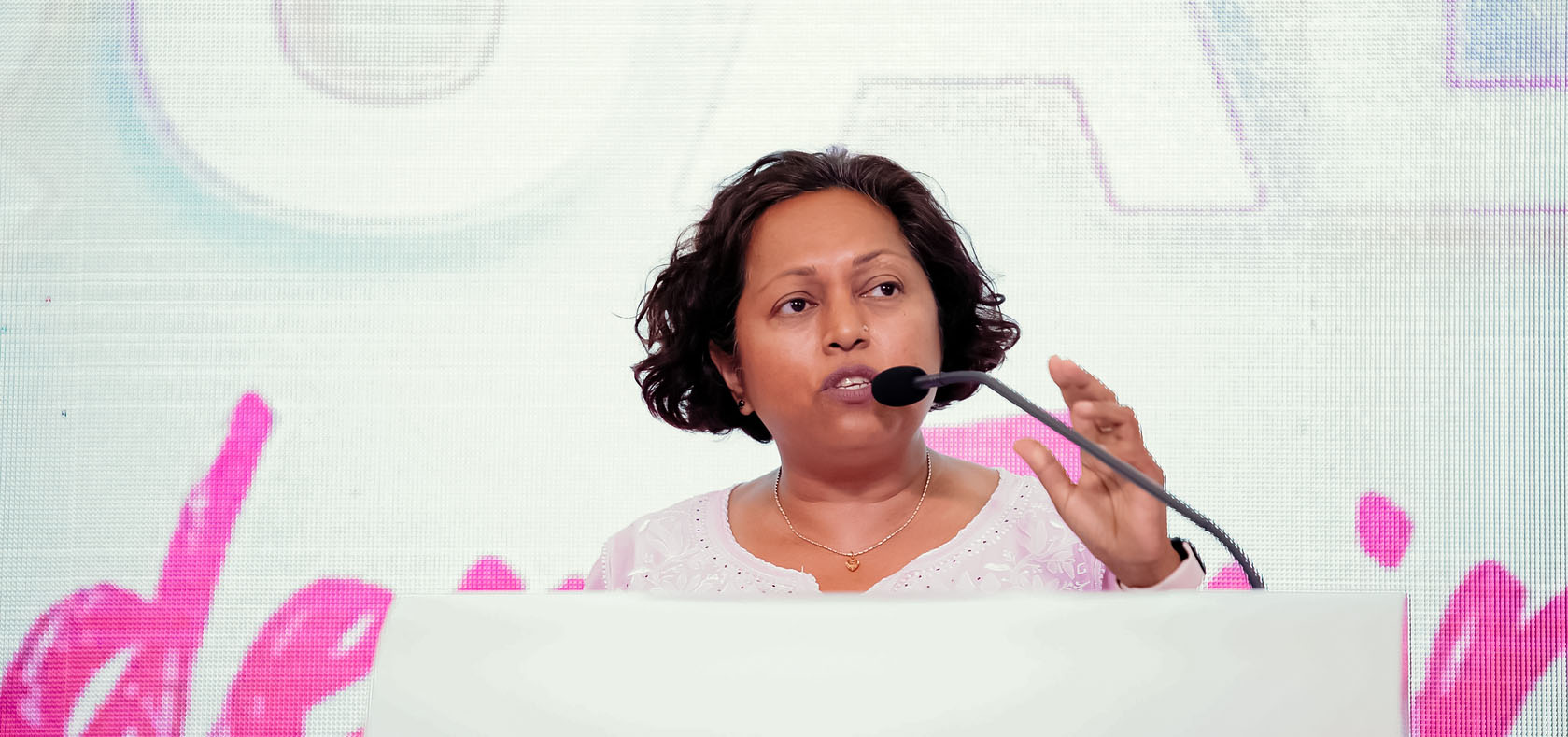
Isabella Menin, Thailand’s Miss Grand International 2022, shared some of her experiences of tackling discriminatory gender norms while pursuing a career in economics, having been asked whether she would have preferred working in a more “traditionally feminine field.”
Actress Poi Trichada Petcharat and actor Ahn Bhuvanath Kunpin shared their experiences of being targets of cyber harassment due to their personal backgrounds and gender identities. They described the detrimental impacts that cyber-enabled harms have on women and persons with diverse gender identities and explored collaborative approaches that could help ensure that digital platforms are peaceful and gender-responsive.

Cindy Sirinya Bishop, Thai model, actress and the Regional UN Women Ambassador for Asia and the Pacific, shared her commitment to countering gendered cyber harms and her experiences working as an activist to prevent violence against women through the “Don’t Tell Me How to Dress” project.
All speakers stressed that public awareness needs to be strengthened of the gendered dynamics of cyber-harms and that women’s leadership must be at the core of change-making processes that strive to leverage inclusive and peaceful digital platforms. This is crucial to ensuring that women equally participate in digital processes, from technology development and policymaking to online civic engagement and peace efforts.
In a similar fashion, UN Women Regional Director a.i. Sarah Knibbs noted that “the digital space and new technology, including artificial intelligence, carry the vast potential to improve political, social and economic outcomes for women, young women and girls — if we can close the digital divide and improve women’s representation in this sector.”
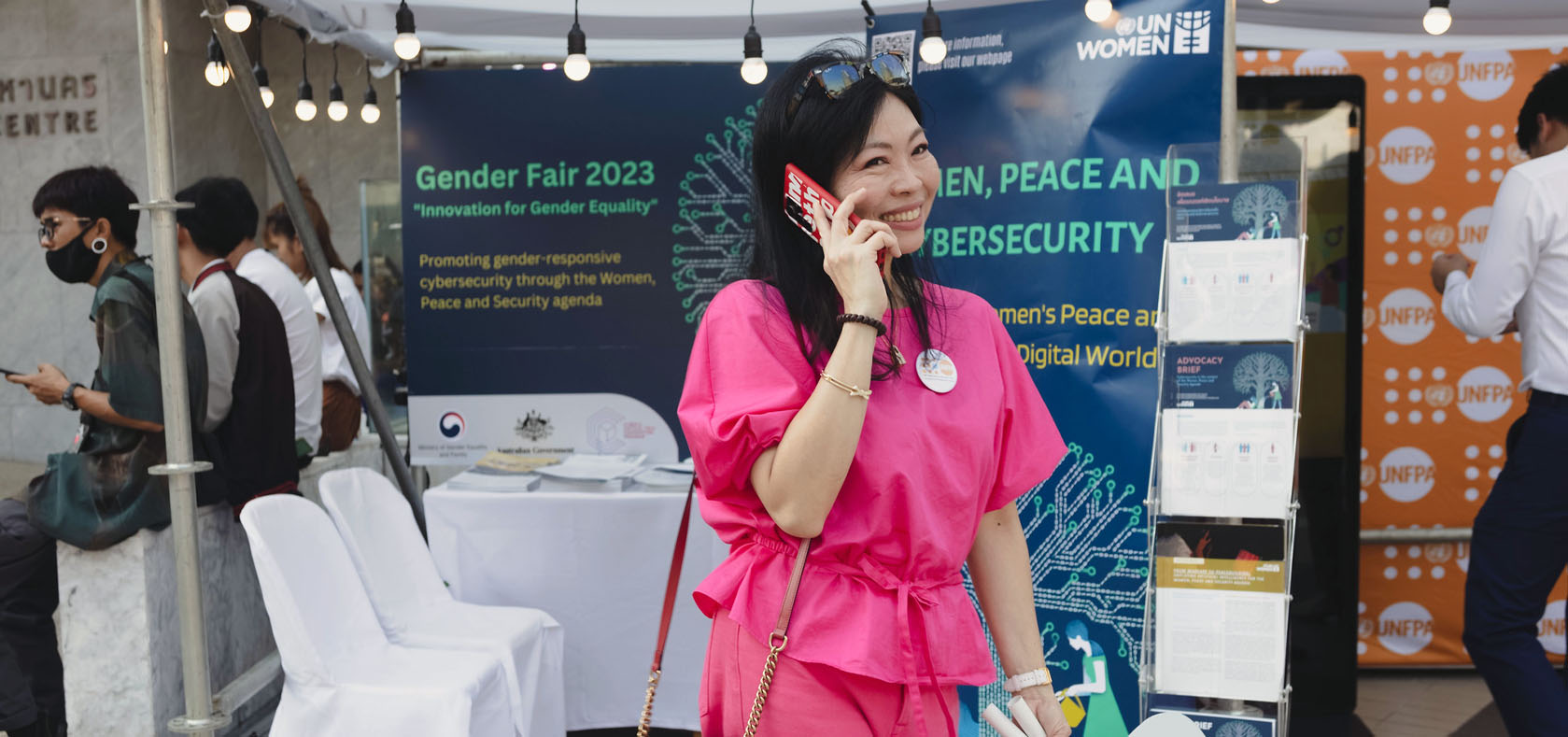
This event was organized under the regional project Women, Peace and Cybersecurity: Promoting Women’s Peace and Security in the Digital World. The project, supported by the Governments of the Republic of Korea and Australia, aims to ensure that governments, civil society and cyber defenders have increased access to information and capacity-building support to advance gender-responsive cybersecurity, informed by the commitments to the United Nations Security Council Resolution (UNSCR) 1325. For more information, visit the project webpage
- ‘One Woman’ – The UN Women song
- Christine Arab
- Guiding documents
- Report wrongdoing
- Procurement
- Internships
- Facts and Figures
- Creating and Implementing Laws
- Creating Safe Public Spaces
- Preventing Violence against Women
- Raising Awareness and changing social norms
- Essential services for women
- UNiTE Asia Pacific
- Safe and Fair
- Our Resources
- Training of Trainers (ToT) Package on Gender, Climate Resilience and Disaster Risk Reduction
- Coordination and Leadership
- Capacity Development
- Mainstreaming Gender into Data, Analysis and Advocacy
- Targeted Programming
- Toolkit for UNCT-SWAP Gender Equality Scorecard Assessment and Action Plan Implementation
- Advancement of human rights of LGBTIQ people
- UN Trust Fund to End Violence in Asia-Pacific
- The Fund for Gender Equality
- Economic Opportunity
- Gender-Responsive Budgeting
- Migrant Workers in the Asia and the Pacific Region
- Women’s Land & Property Rights
- WE RISE Together
- Industry Disruptor Participant Profiles
- UN Women in Action
- Commission on the Status of Women
- Newsletters
- Resources and Publications
- Frequently Asked Questions (FAQ)
- CEDAW SEAP Phase II
- Governance Peace and Security
- Women Peace and Cybersecurity
- Preventing Violent Extremism
- Climate Security and Gender
- Women in Policing
- Conflict Resolution and Peacebuilding
- Protection and Peacekeeping
- National Action Plans
- Rule of Law and Justice
- Preventing Human Trafficking
- Women, Peace and Security, and COVID-19
- Political Participation of Women
- Women’s Access to Justice
- Programme implementation
- Afghanistan
- Income security, decent work and economic autonomy for women
- Women live a life free of violence
- Governance, national planning and budgeting for gender equality
- About UN Women in Cambodia
- Cook Islands
- Federated States of Micronesia
- Peace, Security, Humanitarian and Resilience
- Womens Political Empowerment and Leadership
- Ending Violence Against Women and Girls
- Women’s Economic Empowerment Programme
- Knowledge Products
- Strengthening Response and Service Provisioning for Gender-Based Violence in Tamil Nadu
- Peace and Security
- Leadership and Participation
- National Planning and Budgeting
- Human Rights
- Economic Empowerment
- UN Coordination
- Result at a Glance
- Data on Women
- Partnerships
- Peace Village
- Promoting Women's Human Rights
- About Indonesia
- Our key thematic priorities
- Where we are and what we do
- About Myanmar
- About UN Women Nepal
- Results at a glance
- Economic Empowerment and Sustainable Livelihood
- Ending Violence Against Women (EVAW)
- Partnership and Coordination
- UN Women Pakistan Flood Appeal
- Women Peace and Security and Humanitarian Action
- Governance and National Planning
- Women's Economic Empowerment
- Ending Violence against Women and Girls
- Intergovernmental Processes
- UN Coordination on Gender Equality
- Results at a Glance
- About UN Women Philippines
- Migration Philippines
- Safe Cities Hackathon
- Safe Cities Quezon City
- News and Events
- Publications
- About UN Women Papua New Guinea
- SANAP WANTAIM
- Market Project
- About UN Women
- Director Jeong Shim Lee
- Republic of the Marshall Islands
- Solomon Islands
- Women Peace and Security
- Women’s Economic Empowerment
- Women’s leadership in governance and decision-making
- Preventing violence against women and girls
- Women, Peace and Security
- Women’s Leadership and Participation in Decision Making
- Ending Violence Against Women and Girls (EVAWG)
- Gender Responsive Disaster Preparedness and Response
- United Nations Joint Programme (UNJP)
- Gender Responsive Planning and Budgeting
- Women in Politics
- CEDAW Implementation in Timor-Leste
- One UN Viet Nam
- Government Partners
- National Women’s Machineries
- Civil Society
- UN Women - Nokia
- Foundations
- National Committees
- Cindy Sirinya Bishop
- Karen Davila
- International Financial Institutions
- 30 for 2030
- GenderNet Bootcamp
- Toolkit: Youth Guide to End Online Gender-Based Violence
- Toolkit: Second Edition of the Youth Guide to End Online Gender-Based Violence
- Generation Equality Forum: Asia-Pacific Regional Journey
- About Beijing+25
- Beijing+25 Asia-Pacific Youth Blog
- Generation Equality Forum in Mexico
- Generation Equality Forum in Paris
- #IAmGenerationEquality challenge
- Generation Equality Forum
- Generation Equality Youth Challenge
- Generation Equality 16 Days of Activism
- Our Project
- Our Campaign
- Take Action
- Resources For You
- Media Compact
- Beijing+30 in Asia Pacific
- International Women’s Day 2024
- UN Commission on the Status of Women (CSW68)
- UN Women Asia-Pacific at COP 28
- 16 Days of Activism against Gender-Based Violence
- In Focus: International Women's Day 2023
- In Focus: UN Commission on the Status of Women (CSW67)
- International Day of Rural Women
- International Day of the Girl
- In Focus: UN Commission on the Status of Women (CSW66)
- Gender equality matters in COVID-19 response
- Skilling our women and youth for inclusive and green recovery from COVID-19
- International Day of Women and Girls in Science
- "Girls", Not Objects: Youth Talk and Exhibition
- Geneva Peace Week
- Indigenous women
- World Refugee Day
- World Humanitarian Day
- Essential Services Package for Women and Girls Subject to Violence
- Empowering women to conserve our oceans
- Migrant Women and International Migrants Day
- Women refugees and migrants
- Recommit to CEDAW
- Women of Achievement
- Community of Change makers
- Women and the SDGs
- International Youth Day 2023
- Voices of Youth from Asia-Pacific
- Expert's take
- In the words of...
- Media Contacts
- Annual Report
- HeForShe Advocates in Asia Pacific
- Activities in our region
- #HeForSheAtHome Challenge
- Become a Supporter

Search form
International women's day 2023 - digitall: innovation and technology for gender equality.

The campaign to reach gender equality in the world is an every day pursuit – but one that takes particular significance today, on International Women's Day.
This year’s theme is “ DigitALL: Innovation and technology for gender equality ” and it acknowledges the role technology plays in the gender divide – unfortunately, the digital world can benefit men and boys more than women and girls. Women must be treated as technology creators and decision-makers and included equally in the design, development, and deployment of technology to better meet their needs.
The Special Representative of the Secretary-General and Head of UNMIK Caroline Ziadeh commends the many positive developments in women’s rights over the past year in Kosovo and around the world and she admires the courage of all women's rights activists striving for equality.
“A gender-equal world is for the benefit of all of society! Let’s work together to make the planet fairer for all, both on- and offline,” she said.
Watch the Secretary-General António Guterres video message on International Women's Day 2023:
Find us on Facebook Find us on Twitter Find us on YouTube Find us on Flickr Find us on Tumblr Find us on Instagram RSS feed
How can digital technology speed up gender equality?
Can digital technologies consign gender inequality to history? Consider that 55 percent of new Internet businesses are founded by women in China. In Indonesia, 35 percent of revenue on the country’s largest online marketplace is earned by women-owned businesses—more than double the share in offline commerce.
Across Asia Pacific, where gender inequality is high, digital technologies can give women a leg up, giving them the flexibility to earn an income as well as look after their families, and boosting economic growth in the process. The latest McKinsey Global Institute research on gender equality on Asia Pacific finds that the region’s economies could increase their collective GDP by $4.5 trillion a year by 2025—or the equivalent of adding an economy the combined size of Germany and Austria every year—by accelerating progress towards gender equality.
Tackling gender inequality is complex, difficult, and slow, but digital can help accelerate progress.
Digital technology can transform women’s lives in a myriad of ways, and quickly. It can, for instance, give many women access to a bank account for the first time. Today, an estimated 57 percent of women are financially excluded in South Asia, 54 percent in China, and 49 percent in Southeast Asia. But because the cost of providing digital finance is 80 to 90 percent lower than physical payments, MGI finds , it can be accessed more broadly.
While women account for half of the population of Asia Pacific, they contribute only 36 percent of GDP. (This doesn’t count the considerable value they create working in the home that is not formally counted in GDP measures, which we estimate—conservatively—is worth the equivalent of 15 percent of the region’s GDP). Again, digital can help bring opportunities to women via technology such as videoconferencing. In Australia, financial services company Suncorp has redesigned its contact center through “work at home hubs” that combine home work stations and working spaces in regional shopping centers.
Using digital technologies can truly transform not only women’s ability to earn money but their health and welfare. Remote delivery of healthcare is spreading. In India, NGO Swayam Shikshan Prayog’s Arogya Sakhi programme uses a mobile application that assists women in becoming health entrepreneurs delivering antenatal and infancy care. Finally, digital gives women more of a voice. In Indonesia, there have been reports of improved social status, bargaining positions and influence on village policies by providing rural women training in digital media.
There is much more to do. More women need access to these technologies. GSMA has estimated that there are 1.1 billion unconnected women in low- and middle-income economies in Asia Pacific. Moreover, digital literacy among many women is low—lower than among men. It is vital that women are given the training in science, technology, and mathematics that will equip them for the industries that will thrive in the automation age . Finally, entrenched attitudes about women and technology also need to be tackled. Consider that in a World Wide Web Foundation survey in Jakarta, more than one-third of male respondents said that it was “their responsibility to restrict what women access on the Internet.” In India, one village in Uttar Pradesh implemented a 2,100-rupee fine for any girl using a mobile phone outside the home.
Digital cannot solve all the challenges that women face, and there are certainly some risks, but if its power to enable women to make the most of their potential is truly tapped, it can turbocharge progress towards gender equality.
This article appeared first in Equals .
Anu Madgavkar, Kweilin Ellingrud and Mekala Krishnan are employees of McKinsey Global Institute.
Explore a career with us

| Format | |
|---|---|
| BibTeX | View Download |
| MARCXML | View Download |
| TextMARC | View Download |
| MARC | View Download |
| DublinCore | View Download |
| EndNote | View Download |
| NLM | View Download |
| RefWorks | View Download |
| RIS | View Download |
Browse Subjects
- UN. Commission on the Status of Women (67th sess. : 2023 : New York)
- GENDER EQUALITY
- EMPOWERMENT
- TECHNOLOGICAL CHANGE

Innovation for gender equality
Publication year: 2019.
- Share to Facebook
- Share to Twitter
- Share to LinkedIn
- Share to E-mail
Rapid technological development and innovation presents new opportunities as well as new challenges. Knowing that innovation and technology does not automatically benefit all alike, UN Women has included innovation as one of the “drivers of change” in its Strategic Plan 2018–2021 .
This brochure showcases some of UN Women’s thoughts and practices around innovation that could accelerate gender equality and women’s empowerment. The examples range from pilot programmes with marginalized beneficiaries to partnerships with start-ups; from frontier technologies to non-tech interventions that challenge mindsets; and from procedural improvements to capacity-building.
We hope this brochure will elicit valuable insight and future collaboration.
Additional documents
- PDF version
Bibliographic information
Related publications.
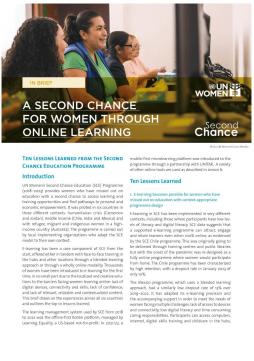
A second chance for women through online learning: Ten lessons learned from the Second Chance Education Programme

Our space is your space: Experiences from the pilot phase of the Second Chance Education and Vocational Learning Programme (SCE) in Australia, Cameroon, Chile, India, Jordan and Mexico

Second Chance Education facilitators’ guide

IMAGES
VIDEO
COMMENTS
The theme for International Women's Day, 8 March 2023 (IWD 2023) is, "DigitALL: Innovation and technology for gender equality". This theme is aligned with the priority theme for the upcoming 67th Session of the Commission on the Status of Women (CSW-67), "Innovation and technological change, and education in the digital age for achieving gender equality and the empowerment of all women ...
Innovation is needed in the learning content itself, using micro-doses that are customized around the exact needs of women. Innovation is needed in building business models that are gender-focused around the currently available and affordable technologies. "Achieving gender equality requires the engagement of women and men, girls and boys.
Innovation and technology can support our work for gender equality and the empowerment of all women and girls for sustainable development. Transformative technology means inclusivity in education but also in other spaces where women still are underrepresented. On this International Women's Day, we want to highlight the importance of ...
At the forefront of building an inclusive digital world for girls and women are several Echidna Global Scholars working on gender equality in and through education across the Global South. Their ...
Generation Equality and the Action Coalition on Technology and Innovation form a powerful, multi-stakeholder platform which seeks to do just that—by accelerating progressive change and concrete impact. Let us be inspired and energize each other. Let us assert that digital rights are women's rights.
Under the theme "DigitALL: Innovation and technology for gender equality", the United Nations Observance of International Women's Day 2023 will highlight the need for inclusive and transformative technology and digital education.
Below is technology and innovation for gender equality essay of 500 words. Innovation and technology have the potential to be powerful tools in promoting gender equality. They can help to break down traditional barriers and empower women to participate fully in society, both economically and socially. However, to realize this potential, it is ...
Echoing the theme of this year's International Women's Day and the 67th session of the Commission on the Status of Women, 'DigitALL: Innovation and Technology for Gender Equality', the Gender Fair highlighted the importance of enhancing women's leadership in technology-related sectors while ensuring that women and girls can engage in ...
The campaign to reach gender equality in the world is an every day pursuit - but one that takes particular significance today, on International Women's Day. This year's theme is "DigitALL: Innovation and technology for gender equality" and it acknowledges the role technology plays in the gender divide - unfortunately, the digital world can benefit men and boys more than women
The digital revolution brings immense potential to improve social and economic outcomes for women. Yet, it also poses the risk of perpetuating existing patterns of gender inequality. This report begins by outlining a conceptual framework for understanding the mutual shaping relationship between gender and technology. It then focuses on three areas to identify opportunities and risks in the ...
2CSW 67 priority theme:" Innovation and technological change, and education in the digital age for achieving gender equality and the empo werment of all women and girls". 1Sustainable ...
Tackling gender inequality is complex, difficult, and slow, but digital can help accelerate progress. Digital technology can transform women's lives in a myriad of ways, and quickly. It can, for instance, give many women access to a bank account for the first time. Today, an estimated 57 percent of women are financially excluded in South Asia ...
Innovation and technological change, and education in the digital age for achieving gender equality and the empowerment of all women and girls : report of the Secretary-General UN. Secretary-General ... Access English: E_CN.6_2023_3-EN - PDF; Español: E_CN.6_2023_3-ES - PDF; ...
At the same time, digital technology is opening new doors for the global empowerment of women, girls and other marginalized groups. From gender-responsive digital learning to tech-facilitated sexual and reproductive healthcare, the digital age represents an unprecedented opportunity to eliminate all forms of disparity and inequality.
⮚ Recommendations on how to better mainstream gender in digital policies and investments - both public and private, and increase women's participation in digital cooperation, as well as how to promote women and girls as innovators. Gender transformative technology and innovation: Technologies are the product of design.
This video highlights the impact of a digital gender gap on economic and social inequalities. It also highlights the importance of protecting women's rights ...
Knowing that innovation and technology does not automatically benefit all alike, UN Women has included innovation as one of the "drivers of change" in its Strategic Plan 2018-2021. This brochure showcases some of UN Women's thoughts and practices around innovation that could accelerate gender equality and women's empowerment. The ...